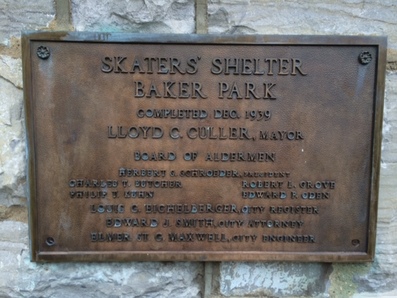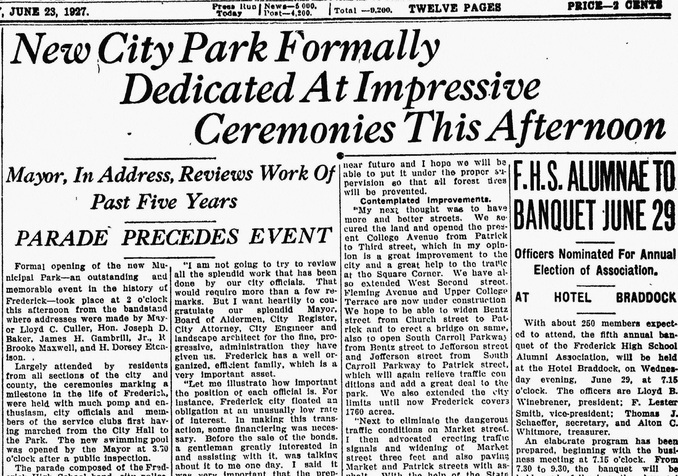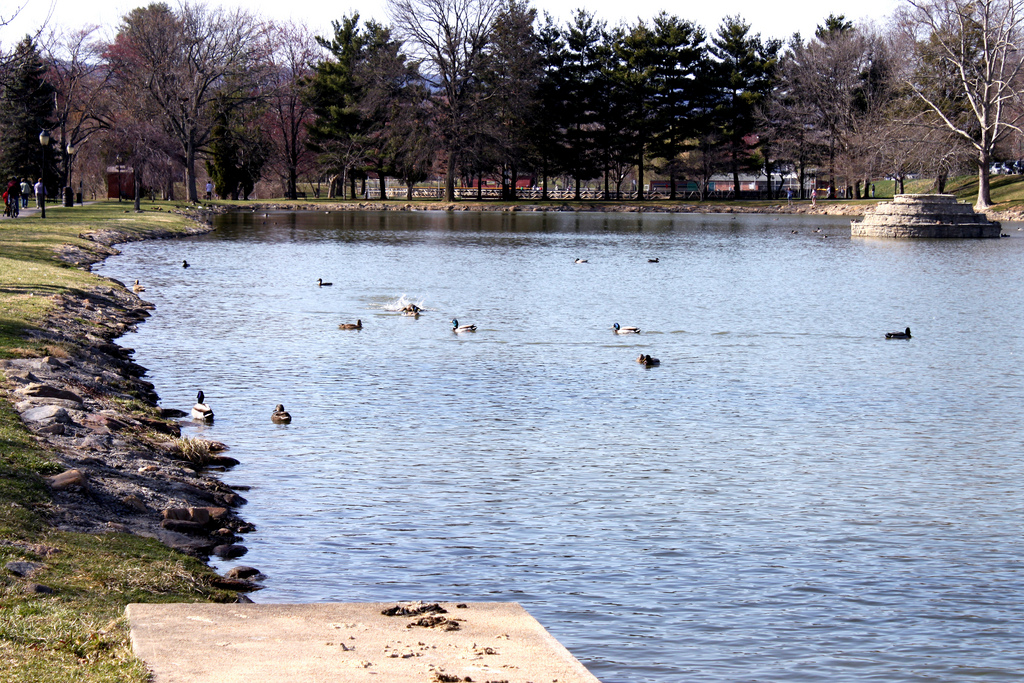HSP HISTORY Blog |
Interesting Frederick, Maryland tidbits and musings .
|
 I have had the good fortune of working for some great employers over the past 26 years. Best of all, I have spent my entire “working career” in the municipal boundaries of Frederick City. I am equally grateful for extremely limited commutes over the years, being one in the minority lucky enough to work within minutes of my home, which is conveniently located northwest of our historic downtown near Fort Detrick. Both my parents suffered through long daily commutes to their respective employers in Bethesda and Silver Spring (MD). In stark contrast, my drive to work is stress-free. Instead of taking US70 to Baltimore, or sitting in bumper to bumper traffic en-route to Washington (DC) via I-270, my drive occasionally takes me on “busy” thoroughfares such as Rosemont Ave, Market Street and the “expressway-esque” Bentz Street—at least in a southerly direction. Important landmarks that dot my way range from Schifferstadt, Baker Park , the Carroll Creek master conduit and that mystifying display window at the southwest corner of West Patrick and Bentz, always creatively decorated for the next major holiday. Instead of the Mormon Tabernacle off the 495 Beltway, I catch scenic glimpses of our famed “Clustered Spires.” Of course, this passage is not to rub it in, as I truly have empathy for the tens of thousands of my Frederick County brethren that have to make that hour plus sojourn twice a day. I sincerely salute all of you. But I do have to say that I have actually felt a fraction of your “commuting pain” from time to time. This downside stems from the occasional delay caused by waterfowl crossing against traffic on W. Second Street, adjacent Culler Lake. Speaking of this latter phenomenon later, my commutes of late have been “duck-free” due to the major renovation project going on at Culler Lake. However, I have been slowed in this vicinity just the same by my inherent desire to rubber-neck in an effort to see the progress on the lake efforts. It’s truly a changed landscape at present, and one that is sure to capture the imagination of Fredericktonians young and old. As for the park itself, it has quite an interesting history that dates back nearly 100 years. The whole plan started as a call was made for a memorial park to honor the local boys who sacrificed the lives for our freedoms in World War I. The former German Reformed Church burying ground, adjacent the junction of Bentz and W. Second Street, was secured. However, a much bigger parcel was desired, one that could provide recreational opportunities for city residents while holding the moniker of Memorial Park in the same vain as Frederick’s aptly named Memorial Hospital some years before. This became quite a big deal and controversial issue in the spring of 1920 as local businessmen, politicians and residents were split over the decision to go after state bonds to the tune of $50,000 to complete the park which was estimated to cost $90,000. The bond request was denied by the General Assembly, but the project creeped forward under private advancement. Enter Joseph Dill Baker and his wife, who purchased two pivotal farm properties west of Bentz Street and selflessly donated them to the cause. It’s interesting to see a connection to the Frederick of today, with the current political debate over funding for a Downtown Conference Center for Frederick. As this has the potential to be a slam-dunk plus for local tourism and business, such was the case with the creation of a municipal park nearly 100 years ago. The local newspapers of the 1920’s are riddled with advertisements and testimonials for Potts & Griffin’s “College Park,” the hottest residential endeavor to ever hit Frederick City. This was part of a major annexation northwest of “old downtown,” where a suburban residential oasis was being created west of Rockwell Terrace. More than a conference center's power to attract tourists to come to town and patronize local stores and residents, “the Northwest Addition” (as it was called) had the ability to permanently grow Frederick's population by attracting new residents to town. And how could the "new neighborhood" be any sweeter with the potential of promising buyers a beautiful park space in the near future, built smack dab in the midst of their residential development? Property values would (and did) soar, and everybody involved became a winner. It's no wonder the College Park Company corporation was composed of the brightest business minds in Frederick County.  Lloyd C. Culler (1869-1960) Lloyd C. Culler (1869-1960) Municipal Park, as it was originally called, officially opened on June 23, 1927 amidst tremendous fanfare. Within two month’s time, Frederick’s mayor would have the recreational area’s name changed to Baker Park in an effort to appropriately thank the pivotal benefactors—Mr. and Mrs. Baker. This was a gentleman named Lloyd C. Culler. Culler grew up in the Feagaville area and initially worked on the family farm before opening his own construction business which would become one of the busiest contract building firms in Frederick history. He was a close friend of Mr. Baker, and his company surely benefitted from this relationship for Baker was a powerful businessman, banker and philanthropic legend which gained him of the title: "Frederick's First Citizen." Culler also knew the ins and outs of politics, serving as mayor from 1922-31, and again from 1934-40. Mr. Baker’s Citizen’s National Bank would flourish as well thanks to the residential home loans “College Park” would bring.  As I said, the new park was an inviting amenity for home buyers, just as it is today. And the addition of a controlled, passive water element in addition to the wily Carroll Creek was an added bonus. This took the form of a man-made lake, whose inspiration came from an existing pond used by the Kidwiler family who owned this parcel before it went to parkland and City. The Kidwilers used the pond for ice production in winter and raising goldfish in summer. Residents in the know had come here for ice skating for years. Now this location was going to provide recreation for all: ice skating in winter and boating/fishing in summer. Construction began in late fall of 1926 through the winter of 1927. A decade later, in the throes of the Great Depression, the Works Progress Administration was contracted to enlarge and deepen the Municipal Pond and stabilize its embankments. On January 7, 1940, the pond would be named Culler Lake in honor of the longtime mayor and dedicated public servant who along with Joseph D. Baker, made the park a reality. Coincidentally, the hard-working Chairman of the Municipal Park Project would also have his name memorialized, but not herein this park. This was local miller, outdoorsman and outspoken conservationist James H. Gambrill. His namesake park had been unveiled in 1934. Culler Lake has two trademark features: the Skater’s Shelter (commonly called the Boat House) and the fountain within. This week, you won't find the main ingredient of Culler Lake, that being H20. The water has been completely drained so construction crews can do their job which includes extensive dredging of the lake bottom and “shoring up” the shoreline. This is difficult, dirty work, as new landscaping elements and ornamentation will come later. As I snapped a few pictures the other morning, I marveled as a bulldozer almost appeared to be sucked into the mud and muck. I started thinking about the chemical composition of that lake bottom and quickly recalled the signs pleading visitors not to feed the ducks. Regardless, a fowl thought, and equally fowl part of this exciting renovation for those employees of Morgan-Keller, contractor for the project.  Vintage Z104 belt buckle (ca. 1982)from the author's personal collection Vintage Z104 belt buckle (ca. 1982)from the author's personal collection I couldn't help to flash back to my childhood and my most memorable times at Culler Lake. Although revived recently, the bathtub races of the early 80's were quite a hometown event. Radio station Z104 (aka WZYQ) was instigator and host to the annual revelry which included plenty of “Hit-Crankin', Hot Rockin’ music," and legendary deejay Kemosabi Joe (who I am proud to have as a FaceBook friend, and more so, was a childhood icon of mine turned real-life co-worker for my first ever job at Skatehaven Roller Rink (1984-85) as a deejay. In recent years, archeologists have found a myriad of artifacts on the grounds of Schifferstadt Architectural Museum. These represent an interesting cross section of Frederick City’s 270+ year history and beyond going back thousands of years with Native American finds such as spear points and pottery shards. I wonder if any of the Culler Lake construction crew will find a Kidwiler family heirloom, stray ice skate, or the hull of an ill-fated bathtub from yesteryear? At the very least a coveted Z104 belt buckle? One can only hope as they are all lost treasures of Frederick’s glorious past. Thanks to renovation projects like this, and those who have led the charge and others who have donated the funds to perform them, Frederick will have an equally glorious future. Those damn ducks better appreciate all the work that is being done to improve their glorious W. Second Street home.
3 Comments
Harriet Wise
4/15/2016 03:59:41 am
Well done !!! Make sure I am on your send list...Harriet
Reply
Tony
8/7/2016 10:02:50 pm
We fished in Culler lake a couple times in the 90s and I recall a healthy population of bluegills and maybe catfish. So what happened to the fish when the lake was dredged?
Reply
2/10/2020 08:41:11 pm
Fishing off the point is best served for boaters who can get out into much deeper waters, but fish can be caught from shore as well
Reply
Leave a Reply. |
AuthorChris Haugh Archives
February 2024
Categories |









 RSS Feed
RSS Feed